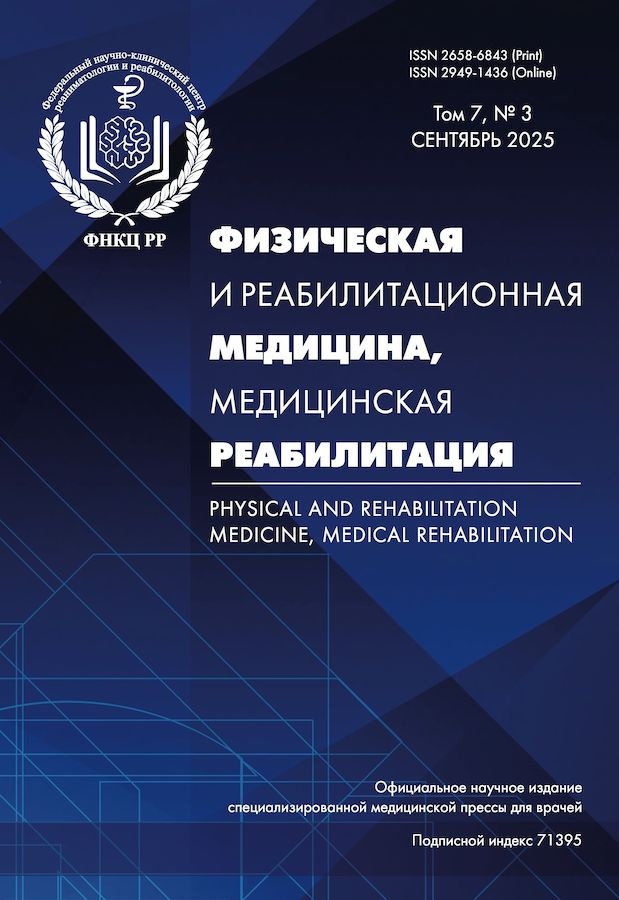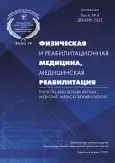Классификация последствий и осложнений позвоночно-спинномозговой травмы у детей
- Авторы: Новосёлова И.Н.1,2, Понина И.В.1, Валиуллина С.А.1
-
Учреждения:
- Научно-исследовательский институт неотложной детской хирургии и травматологии
- Российская медицинская академия непрерывного профессионального образования
- Выпуск: Том 4, № 4 (2022)
- Страницы: 234-243
- Раздел: ОРИГИНАЛЬНОЕ ИССЛЕДОВАНИЕ
- URL: https://journals.rcsi.science/2658-6843/article/view/232718
- DOI: https://doi.org/10.36425/rehab114841
- ID: 232718
Цитировать
Полный текст
Аннотация
Обоснование. На результат лечения и исход позвоночно-спинномозговой травмы у детей существенно влияет наличие последствий и осложнений, возникающих на всех этапах восстановления. Предложенная в 1994 году классификация не даёт чётких разграничений между понятиями «последствия» и «осложнения» и, на наш взгляд, давно устарела, поскольку вызывает больше вопросов, чем содержит ответов.
Цель исследования ― предложить новую классификацию последствий и осложнений позвоночно-спинномозговой травмы, охватывающую все периоды течения травмы.
Материалы и методы. В исследовании принимали участие дети с тяжёлой позвоночно-спинномозговой травмой, поступившие в НИИ НДХиТ с 2014 года. Для диагностики актуального состояния использовали клинический осмотр с определением трофологического статуса, неврологическую оценку по шкале ASIA, исследование локомоторного паттерна, лабораторный и инструментальный мониторинг. Кроме того, проводилось психологическое обследование с целью выявления постравматической дезадаптации и психопатологических состояний.
Результаты. Последствия позвоночно-спинномозговой травмы через 3 года после получения травмы выявлены у 96% пострадавших детей, осложнения позвоночно-спинномозговой травмы ― у 56% детей с позвоночно-спинномозговой травмой, поступивших в НИИ НДХиТ в 2014–2020 гг. Разработана новая классификация последствий и осложнений позвоночно-спинномозговой травмы у детей.
Заключение. Раннее начало реабилитационных мероприятий и последующее длительное медико-психологическое сопровождение детей с позвоночно-спинномозговой травмой отдаляет возникновение последствий травмы спинного мозга, профилактирует осложнения и побуждает ребёнка и его родителей соблюдать рекомендации реабилитационной команды. Недооценка тяжести состояния ребёнка с позвоночно-спинномозговой травмой может привести не только к ограничению двигательных возможностей, но и затруднению интеграции его в общество, а соответственно, ухудшению качества жизни всей семьи.
Разработанная новая классификация является необходимой для улучшения исходов травмы, дальнейшего роста и развития ребёнка и интеграции его в социальную среду.
Полный текст
Открыть статью на сайте журналаОб авторах
Ирина Наумовна Новосёлова
Научно-исследовательский институт неотложной детской хирургии и травматологии; Российская медицинская академия непрерывного профессионального образования
Автор, ответственный за переписку.
Email: i.n.novoselova@gmail.com
ORCID iD: 0000-0003-2258-2913
SPIN-код: 1406-1334
д.м.н.
Россия, Москва; МоскваИрина Витальевна Понина
Научно-исследовательский институт неотложной детской хирургии и травматологии
Email: ponina.irina@mail.ru
ORCID iD: 0000-0002-0060-7895
SPIN-код: 1753-6156
Россия, Москва
Светлана Альбертовна Валиуллина
Научно-исследовательский институт неотложной детской хирургии и травматологии
Email: vsa64@mail.ru
ORCID iD: 0000-0002-1622-0169
SPIN-код: 6652-2374
д.м.н., профессор
Россия, МоскваСписок литературы
- Hagen E.M. Acute complications of spinal cord injuries // World J Orthopedics. 2015. Vol. 6, N 1. P. 17–23. doi: 10.5312/wjo.v6.i1.17
- Иванова Г.Е., Мельникова Е.В., Белкин А.А., и др. Как организовать медицинскую реабилитацию? // Вестник восстановительной медицины. 2018. № 2. С. 2–12.
- Новосёлова И.Н., Понина И.В., Валиуллина С.А. Осложнения и последствия позвоночно-спинномозговой травмы у детей и взрослых. Обзор литературы // Российский нейрохирургический журнал им. профессора А.Л. Поленова. 2020. Т. 12, № 1. С. 48–54.
- Новосёлова И.Н., Мачалов В.А., Понина И.В., и др. Концепция ранней реабилитации детей с позвоночно-спинномозговой травмой в условиях хирургического стационара // Вестник восстановительной медицины. 2020. № 2. С. 94–101. doi: 10.38025/2078-1962-2020-96-2-94-101
- Бабиченко Е.И. Классификация позвоночно-спинномозговой травмы // Нейротравматология: справочник / под ред. А.Н. Коновалова, Л.Б. Лихтермана, А.А. Потапова. Москва: Вазар-Ферро, 1994. С. 252–253.
- Джуманов К.Н., Перфильев С.Б., Бабаханов Ф.X. Вопросы лечения ранних осложнений у больных с травмами грудопоясничного отдела позвоночника // VII Поленовские чтения: тезисы Всероссийской научно-практической конференции, 27–30 апреля. Санкт-Петербург, 2008. С. 97–98.
- Леонтьев М.А. Эпидемиология спинальной травмы и частота полного анатомического повреждения спинного мозга // Актуальные проблемы реабилитации инвалидов: материалы научно-практической конференции, посвященной европейскому и российскому году инвалидов-2003, 60-летию Кемеровской области, 25-летию Федерального государственного учреждения «Новокузнецкий научно практический центр медико-социальной экспертизы и реабилитации инвалидов», 30 сентября – 3 октября. Новокузнецк, 2003. С. 37–38.
- Сеничев А.А., Лебедева Н.Б., Белова А.Н. Основные виды и структура поражения органов мочевой системы у больных, перенесших позвоночно-спинномозговую травму // Вятские встречи: сборник научных трудов Кировской межрегиональной научно-практической конференции неврологов и нейрохирургов. Киров, 2004. С. 106–107.
- Соленый В.И. Ортопедические последствия позвоночно-спинномозговой травмы // Нейротравматология: справочник / под ред. А.Н. Коновалова, Л.Б. Лихтерман. Москва: Вазар-Ферро, 1994. С. 267–268.
- Johnston T.E., McDonald C.M Health and fitness in pediatric spinal cord injury: medical issues and the role of exercise // J Pediatr Rehabil Med. 2013. Vol. 6, N 1. Р. 35–44. doi: 10.3233/PRM-130235
- Vogel L.C., Mendoza M.M., Schottler J.C., et al. Ambulation in children and youth with spinal cord injuries // J Spinal Cord Med. 2007. N 30. P. 158–164. doi: 10.1080/10790268.2007.11754595
- Shavelle R.M., DeVivo M.J., Brooks J.C., et al. Improvements in long-term survival after spinal cord injury? // Arch Phys Med Rehab. 2015. Vol. 96, N 4. P. 645–651. doi: 10.1016/j.apmr.2014.11.003
- Nelson V.S. Durable medical equipment for children with spinal cord dysfunction: implications of age and level of injury // J Spinal Cord Med. 2007. N 30. Р. 172–177. doi: 10.1080/10790268.2007.11754597
- Schuld C., Franz S., Brüggemann K., et al. International standards for neurological classification of spinal cord injury: impact of the revised worksheet (revision 02/13) on classification performance // Journal of Spinal Cord Medicine. 2016. Vol. 5, N 39. Р. 504–512. doi: 10.1080/10790268.2016.1180831
Дополнительные файлы












